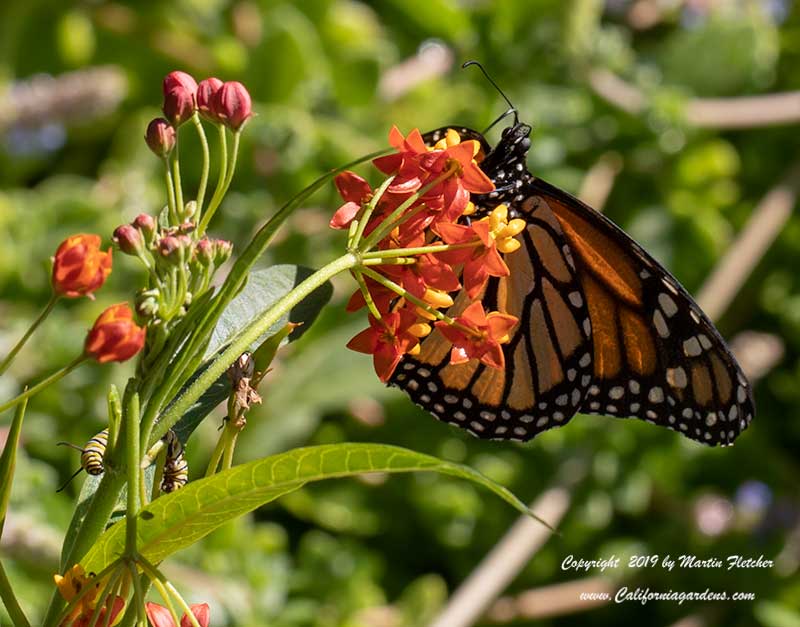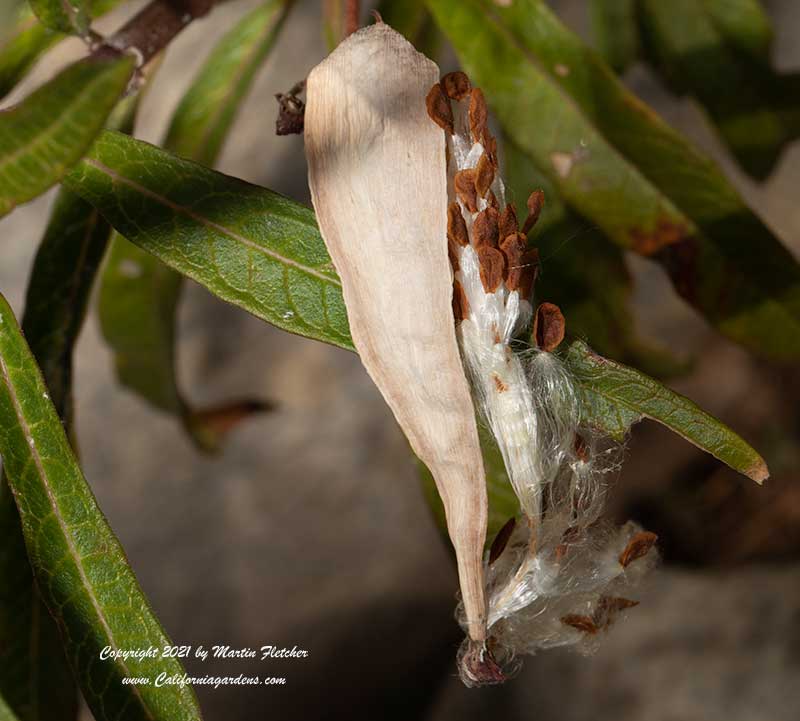Asclepias curassavica with Monarch and Caterpillar * Tropical Milkweed, Bloodweed
Asclepias curassavica is a solid Monarch attractor but it is also one of the tropical milkweeds that have been in the news for the wrong reasons. Asclepias curassavica cultivars have been implicated in being a vector for a protazoan parasite OE that infects Monarch Butterflies. This Tropical Milkweed plant has both an adult Monarch nectaring and a caterpillar feeding on the leaves. Asclepias curassavica will often recover from a severe muching by the Monarchs. The Tropical Milkweeds don't go dormant as readily as the native species. This allows protazoan populations to build up and continue to infect Monarchs all year. A sharp pair of pruners can break this cycle. Call it artificial dormancy, cut your plants back to about 2" tall removing all foliage once or twice a winter. This way you can enjoy Asclepias curassavica without the guilt of doing harm to the Monarch Butterflies. Several other species in the milkweed family have also been found to be vectors for this OE protazoan as well and should be given the same forced dormancy treatment. Bloodweed is another name for this popular butterfly attractor. Asclepias curassavica has sprays of yellow and red flowers late Spring to frost. Asclepias curassavica is also a nector source for the Gray Hairstreak, Painted Lady, Common Buckeye, Northern White Skipper, Mormon Metalmark, Great Purple Hairstreak, California Common Ringlet, Giant Swallowtail, Hedgerow Hairstreak, and Tarantula Hawk. Plant Asclepias curassavica in partial shade to full sun. The Tropical Milkweed can take some drought but will look much better and recover far more readily with a reasonable water diet particularly if it is planted in a sunny location. Asclepias curassavica is native to American Tropics. Asclepias curassavica can grow to 3-4 feet tall and wide. The tops will die back with any significant frost but these Tropicl Milkweed plants are potentially root hardy into the teens. Asclepia curassavica seeds germinate without assistance in gardens where they are planted, often providing opportunity to rescue plants from walkways and inopportune landing zones to be transplanted in a better location.

Flowers and foliage of Asclepias curassavica the Tropical Milkweed or Bloodweed. High resolution photos are part of our garden image collection.

Seeds emerging from an opening pod Asclepias curassavica the Tropical Milkweed or Bloodweed. High resolution photos are part of our garden image collection.
Tarantula Hawks, Carpenter Bees and Yellow Faced Bumblebees feeding on nectar from Asclepias eriocarpa, Woollypod Milkweed. Milkweeds are important to so much more wildlife beyond butterflies. High resolution videos are part of our garden image collection.
Plants from the old Asclepidacea Family featured on this site. This is now considered a subfamily in the Apocynaceae Family or Dogbane Family. This is relevant because these plants are nectar and caterpillar food for the Monarch Butterflies:
Asclepias angustifolia * Arizona Milkweed
Asclepias californica * California Milkweed
Asclepias cordifolia * Purple Milkweed
Asclepias curassavica * Tropical Milkweed
Asclepias curassavica Red Butterflies * Red Butterflies Tropical Milkweed
Asclepias curassavica Silky Gold * Silky Gold Tropical Milkweed
Asclepias eriocarpa * Woollypod Milkweed, Indian Milkweed, Kotolo Milkweed
Aslepias erosa * Desert Milkweed
Asclepias fascicularis * Narrow Leaf Milkweed
Asclepias linaria * Pine Needle Milkweed
Asclepias speciosa * Showy Milkweed
Asclepias subulata * Rush Milkweed, Skeleton Milkweed
Asclepias tuberosa * Butterfly Weed
Other milkweed relatives:
Araujia sericifera * Bladder Vine, Cruel Vine, Moth Vine
Gomphocarpus fruticosus * Swan Milkweed, Narrow Leaf Cotton Plant
Gomphocarpus physocarpus * Family Jewels, Hairy Balls
Hoya carnosa * Wax Vine
